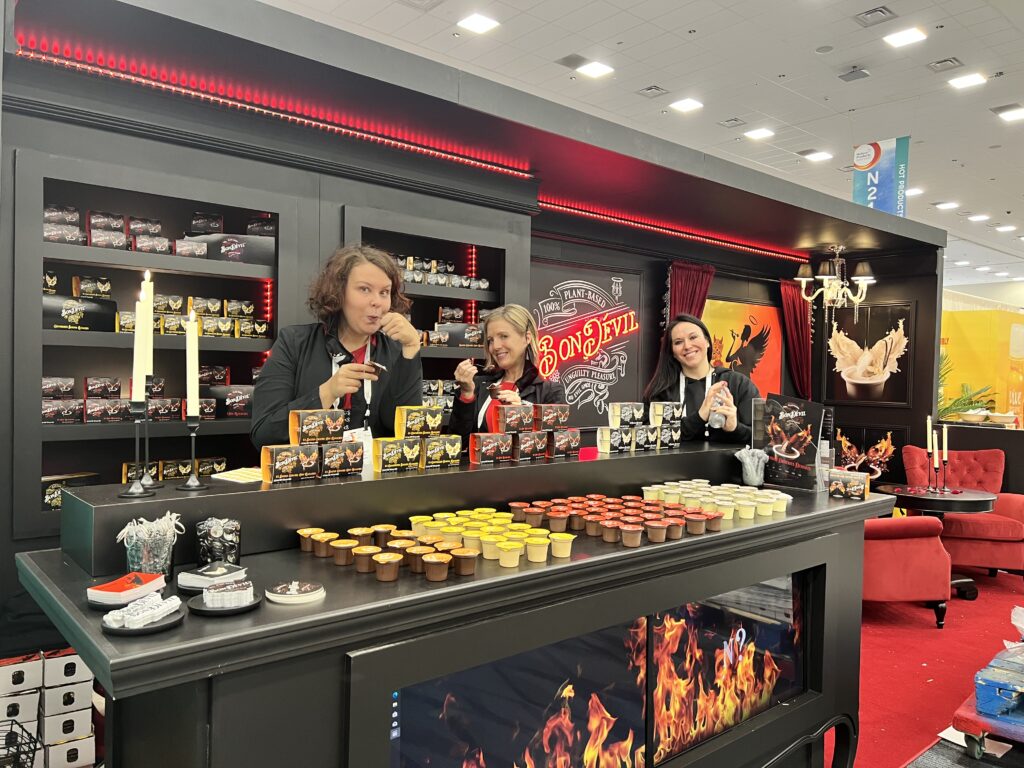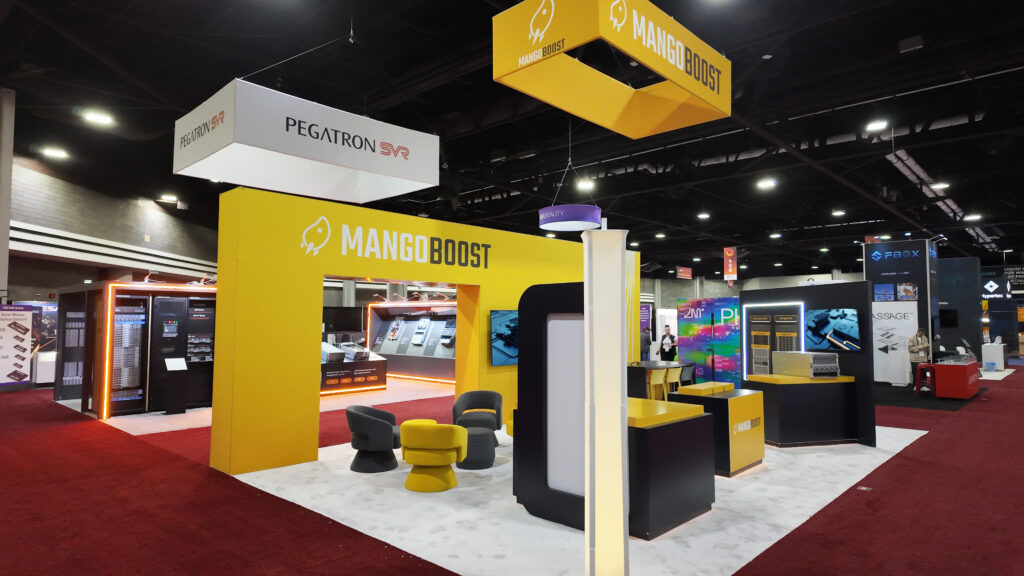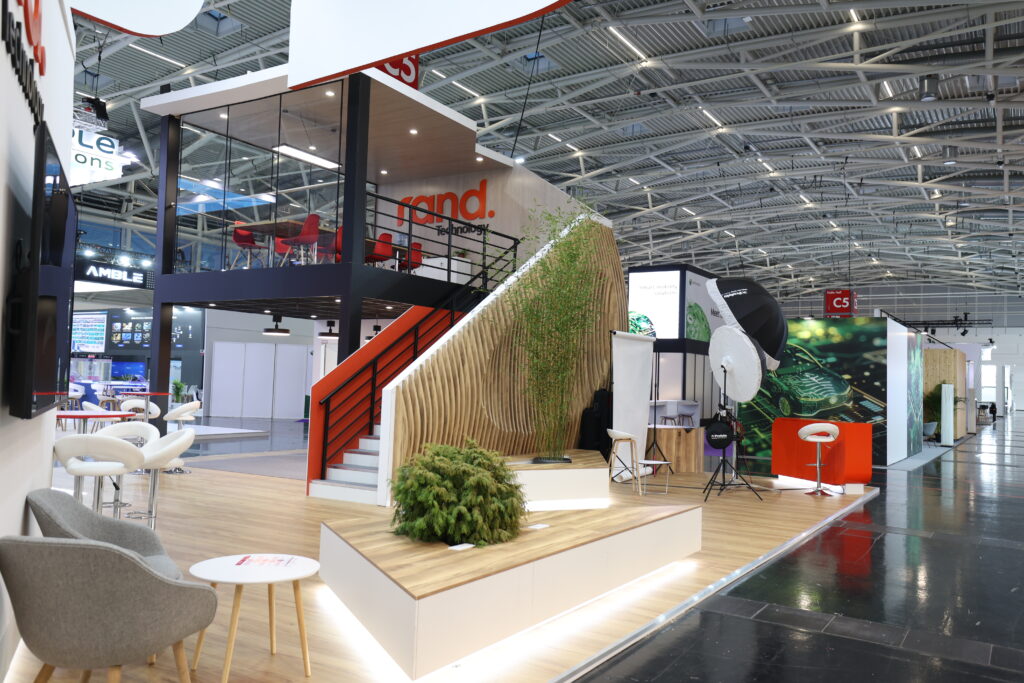Exhibiting at a trade show is a wonderful way to connect with potential customers, partners, and industry influencers. The task at hand is standing out in a sea of competitors, and we believe that having the right booth is truly the key. The type of booth you choose can have a significant impact on your visibility, engagement, and overall trade show success. We understand it can get overwhelming; from standard booths to immersive experiences, there are so many options to consider.
Don’t fret! In this blog post, we’ll break down the most common booth types and help you determine which one is best suited for your brand’s goals, with some of our best Reaction Space (RS) tips on how to make the most of your space.
1. The Standard Trade Show Booth
A standard or inline booth space is the most common option for trade shows, especially for smaller businesses, those with tighter budgets, newcomers, or those unable to secure a bigger booth space. These booths are located along aisles and typically only have one open side for visitors to approach.
- Size: Standard booths often come in sizes like 10×10, or 10×20.
- Pros: Cost- effective, easier to design, and great for basic displays. Companies who do 10×20 spaces typically also have some 10×10 configurations as these two sizes are quite easy to design in a modular fashion to bounce between sizes from show to show, while helping to keep costs low.
- Cons: Inline booths are positioned on an aisle with neighbors, which means your visibility is lower. Additionally, they often come with stricter height and design restrictions, limiting your ability to create a standout presence. These booths also typically don’t allow hanging signs, further limiting your brand’s visibility and impact.
Best for: Startups, small businesses, or companies that have limited products to showcase
RS tip: Just because it’s a smaller space, doesn’t mean that you can’t customize it to be a great experience for your attendees. With the right budget, even a small space can be a show stopper. If you do have a tight budget and can’t splurge on too many customizations, make sure your graphics are bold and communicate your brand message clearly and from a distance. Keep your focus on your core message or product.

2. The Corner Trade Show Booth
As the name suggests, corner booths are located at the intersection of two aisles. This type of booth allows you to have two open sides, increasing both foot traffic and visibility.
- Size: Typically, 10×10, 10×20, 20×20, but can vary depending on the layout of the event.
- Pros: Increased visibility and foot traffic compared to a standard booth. The extra side can be used to display more products, engage attendees in creative ways, and have additional branding and key messaging.
- Cons: Likely to be more expensive due to the prime location, and there may also be increased competition from other businesses looking to shine in the area. Not opened all around to increase foot traffic.
Best for: Businesses that want increased exposure and have enough budget to take advantage of a more strategic location.
RS tip: We’re glad you asked! Take full advantage of your two-for-one visibility with two open sides. Make sure that your design not only attracts visitors from both sides but also that each side attracts different types of visitors. One side can highlight your main product, while the other can draw in people with an engaging display or interactive experience.
3. The Peninsula Trade Show Booth
A peninsula is a great choice for businesses that want more exposure than a corner booth but don’t have the space or budget for an island. It features aisles on three sides, allowing for a higher flow of foot traffic and visibility compared to a traditional inline booth.
- Size: Typically 10×20, 20×20, 20×30, or larger depending on the event layout.
- Pros: Increased exposure due to the three open sides. Offers more space for branding, product displays, and customer interaction. Can give your booth a premium feel without the cost of an island booth.
- Cons: Can still face competition from other nearby booths, and larger setups require careful planning to maintain an organized, flowing space.
Best for: Companies looking for increased visibility and engagement opportunities but don’t need the scale of an island booth.
RS tip: Maximize the three open sides by thinking about different ways to pull in attendees. Use one side for high-visibility branding, another for interactive experiences or product demos, and the third for product displays or meetings. Ensure that visitors can flow through your space comfortably from all directions.
4. The Island Trade Show Booth
Island booths are the top-of-the-line, and premium choices when it comes to trade shows. These booth spaces are for those looking to make a major statement. They are typically located in the center of a trade show, with aisles on all four sides, allowing for maximum visibility and access from every direction.
- Size: These booths typically start at 20×20 feet but can be much larger depending on the event.
- Pros: The sky is the limit. You have unmatched visibility, allowing your company to stand out from all directions. You have more flexibility on the design of your booth: how interactive you want it to be, its height, branding additions such as hanging signs, which activations and immersive experience you want to have, your product demos, meeting spaces, and so on.
- Cons: These are typically more expensive, both in terms of rental space and booth construction. Larger booth sizes can be overwhelming without the right strategy.
Best for: Bigger companies, those with more complex products, with the right budget, who want to create an immersive experience or need space to accommodate a larger team and products. Also, companies looking to transition from the smaller booths into the larger spaces to test the waters before going any bigger.
RS tip: With great visibility comes great responsibility! While the potential for impact is huge, island booths really require strategic planning and a more significant budget. Make sure you partner with an experienced event partner to help with everything from logistics to creative design to fabrication, ensuring your booth shines without being overwhelming.

5. The Immersive Trade Show Booth
Immersive booths go beyond traditional trade show setups by creating an engaging, experiential environment. These booths often incorporate virtual reality (VR), augmented reality (AR), live demonstrations, multimedia installations, or activations to captivate attendees in unique ways.
- Size: Immersive booths can vary in size, but they often require more space (usually 20×20 feet or larger) to accommodate the technology and experience.
- Pros: A great way to draw attention and keep attendees engaged for longer periods. Can create memorable brand experiences that leave a lasting impression.
- Cons: Can have high setup costs, including technology and specialized staff. Requires significant planning and coordination to execute successfully.
Best for: Companies in industries like tech, gaming, entertainment, or any brand looking to create a truly memorable and engaging experience.
RS tip: Immersive doesn’t always have to be expensive. You don’t need the latest VR headset or the biggest space to create a powerful experience. Focus on engaging attendees’ senses and emotions in ways that feel personal and impactful. Get creative with your lighting, soundscapes, and storytelling through your graphics or videos. With thoughtful design and clever activations, you can make your booth stand out—without the hefty price tag.
5. The Pop-Up Trade Show Booth
Pop-up booths are a portable, cost-effective option for businesses looking for a quick setup and teardown. These booths typically use lightweight materials and modular designs that can be easily packed up and shipped from show to show.
- Size: Typically, 10×10 feet or smaller.
- Pros: Affordable and convenient. Easy to transport and store, making them a good option for businesses attending multiple shows or smaller events or for companies who want their own staff to be able to set up and take down
- Cons: Less customizable and often doesn’t have the same visual impact as larger, more elaborate booths.
Best for: Small businesses, startups attending smaller trade shows, companies with multiple regional events.
Rs tip: Focus on bold, high-impact visuals that can be quickly set up—like a large graphic backdrop, a retractable banner, or tabletop display. Utilize the space you have wisely with simple but engaging activations, like product demos or giveaways that draw people in.

6. Double-Decker Trade Show Booth
For companies looking to add an extra layer of luxury and exclusivity, double-decker booths are a great choice. These booths feature two levels, with the upper deck offering additional space for meetings, presentations, or VIP engagement. These are also great for companies who can’t get a larger floor space but need more square footage. By adding another level to your booth space and taking the square footage up instead of out, you can add more space to your exhibit without needing to purchase a larger booth space.
- Size: Larger booths, typically 20×30 feet or larger, with an upper deck or second level.
- Pros: Provides a unique way to showcase products, create a private meeting space, or offer a distinctive experience. High visibility and attention-grabbing.
- Cons: Requires a larger budget, and more planning for construction, safety regulations, and logistics.
Best for: High-profile brands or companies with larger budgets looking to create a standout presence.
RS tip: That upper deck should be functional. Use it to create a VIP area or private meeting space that’s both functional and exclusive, while keeping the ground floor open and engaging.

Conclusion
Selecting the right type of booth depends on your business goals, budget, and the nature of the trade show. Here’s a quick summary to guide your decision-making:
- Standard Booth: Ideal for businesses with a limited budget or simpler display needs.
- Corner Booth: Great for increased exposure without the high cost of an island booth.
- Island Booth: Perfect for businesses looking to make a strong visual impact with a large, flexible display.
- Immersive Booth: Best for businesses wanting to offer an engaging, high-tech experience.
- Pop-Up Booth: Excellent for smaller, budget-conscious businesses or events.
- Double-Decker Booth: Suitable for businesses wanting to create a luxury, high-visibility experience.
Ultimately, your booth choice should align with your marketing objectives, the type of audience you want to engage with, and how much you’re willing to invest in creating a standout experience. Now that you have a better idea of booth spaces, here’s a guide on choosing which trade shows to showcase your brand.
